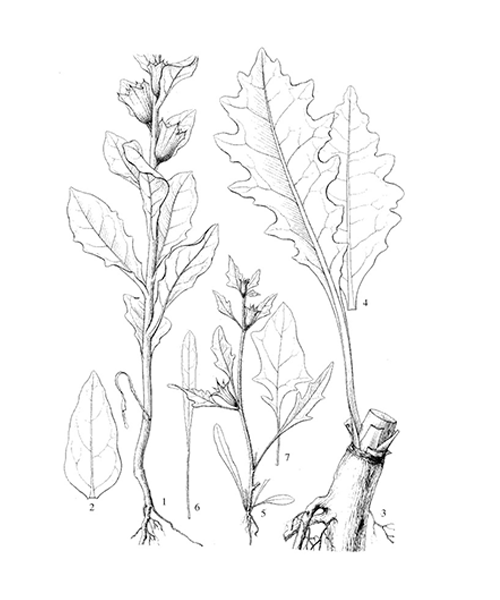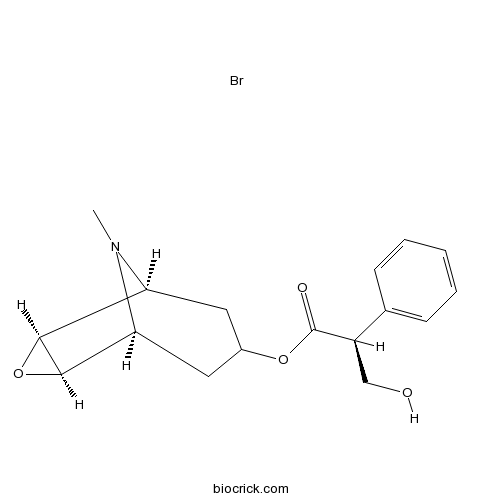Hyoscyamus niger
Hyoscyamus niger
1. The products in our compound library are selected from thousands of unique natural products; 2. It has the characteristics of diverse structure, diverse sources and wide coverage of activities; 3. Provide information on the activity of products from major journals, patents and research reports around the world, providing theoretical direction and research basis for further research and screening; 4. Free combination according to the type, source, target and disease of natural product; 5. The compound powder is placed in a covered tube and then discharged into a 10 x 10 cryostat; 6. Transport in ice pack or dry ice pack. Please store it at -20 °C as soon as possible after receiving the product, and use it as soon as possible after opening.

Natural products/compounds from Hyoscyamus niger
- Cat.No. Product Name CAS Number COA
-
BCN1199
Scopolamine hydrobromide114-49-8
Instructions

-
BCN8343
Racanisodamine17659-49-3
Instructions

Metabolic characterization of Hyoscyamus niger root-specific putrescine N-methyltransferase.[Pubmed: 29549757]
N-methylputrescine is the precursor of nicotine and pharmaceutical tropane alkaloids such as hyoscyamine. Putrescine N-methyltransferase (PMT) catalyzes the N-methylation of putrescine to form N-methylputrescine. While the role of PMT in nicotine biosynthesis is clear, knowledge of PMT in the biosynthesis of tropane alkaloids (TAs) and the regulation of polyamines remains limited. We characterized a PMT gene from Hyoscyamus niger, designated HnPMT that was specifically expressed in roots, especially in the secondary roots and dramatically induced by methyl jasmonate (MeJA). The GUS gene was specifically expressed in Arabidopsis roots or in the vascular tissues, including pericycles and endodermis, of the H. niger hairy root cultures, when it was driven by the 5'-flanking promoter region of HnPMT. The recombinant HnPMT was purified for enzymatic assays. HnPMT converted putrescine to form N-methylputrescine, as confirmed by LC-MS. The kinetics analysis revealed that HnPMT had high affinity with putrescine but low catalytic activity, suggesting that it was a rate-limiting enzyme. When HnPMT was suppressed in the H. niger plants by using the VIGS approach, the contents of N-methylputrescine and hyoscyamine were markedly decreased, but the contents of putrescine, spermidine and a mixture of spermine and thermospermine were significantly increased; this suggested that HnPMT was involved in the biosynthesis of tropane alkaloids and played a competent role in regulating the biosynthesis of polyamines. Functional identification of HnPMT facilitated the understanding of TA biosynthesis and thus implied that the HnPMT-catalyzed step might be a target for metabolic engineering of the TA production in H. niger.
Comparison of two hyoscyamine 6β-hydroxylases in engineering scopolamine biosynthesis in root cultures of Scopolia lurida.[Pubmed: 29407173]
Scopolia lurida, a medicinal plant native to the Tibetan Plateau, is among the most effective producers of pharmaceutical tropane alkaloids (TAs). The hyoscyamine 6β-hydroxylase genes of Hyoscyamus niger (HnH6H) and S. lurida (SlH6H) were cloned and respectively overexpressed in hairy root cultures of S. lurida, to compare their effects on promoting the production of TAs, especially the high-value scopolamine. Root cultures with SlH6H/HnH6H overexpression were confirmed by PCR and real-time quantitative PCR, suggesting that the enzymatic steps defined by H6H were strongly elevated at the transcriptional level. Tropane alkaloids, including hyoscyamine, anisodamine and scopolamine, were analyzed by HPLC. Scopolamine and anisodamine contents were remarkably elevated in the root cultures overexpressing SlH6H/HnH6H, whereas that of hyoscyamine was more or less reduced, when compared with those of the control. These results also indicated that SlH6H and HnH6H promoted anisodamine production at similar levels in S. lurida root cultures. More importantly, HnH6H-overexpressing root cultures had more scopolamine in them that did SlH6H-overexpressing root cultures. This study not only provides a feasible way of overexpressing H6H to produce high-value scopolamine in engineered root cultures of S. lurida but also found that HnH6H was better than SlH6H for engineering scopolamine production.
ITS2 barcoding DNA region combined with high resolution melting (HRM) analysis of Hyoscyami Semen, the mature seed of Hyoscyamus niger.[Pubmed: 28262116]
Hyoscyami Semen, the mature dried seed of Hyoscyamus niger L., has long been used as a traditional Chinese medicine to treat human diseases. Hyoscyami Semen is found in local markets in China. In markets, sellers and buyers commonly inadvertently mix the seeds of H. niger with the seeds of related species such as Hygrophila salicifolia (Vahl) Nees, Astragalus complanatus R. Br., Cuscuta australis R. Br., Cuscuta chinensis Lam., and Impatiens balsamina L. because of their similar morphologies or similar names. Thus, developing a reliable method for discriminating H. niger seeds from its adulterants is necessary to reduce confusion and ensure the safe use of Hyoscyami Semen. The present study was designed to evaluate the efficiency of high-resolution melting analysis combined with DNA barcoding (Bar-HRM) with internal transcribed spacer 2 to discriminate H. niger. Our results show that Bar-HRM successfully identified the adulterants and detected the proportion of H. niger DNA extract within an admixture. In particular, HRM detected H. niger DNA extract in A. complanatus DNA extract at concentrations as low as 1%. In conclusion, the Bar-HRM method developed in the present study for authenticating H. niger is rapid and cost-effective. It can be used in the future to guarantee the purity of Hyoscyami Semen for the clinical use.
[Cloning and characterization of an aromatic amino acid aminotransferase(ArAT) gene involved in tropane alkaloid biosynthesis from Hyoscyamus niger].[Pubmed: 29911833]
Tropane alkaloids are anticholinergic drugs widely used clinically. Biosynthesis of tropane alkaloids in planta involves a step of transamination of phenylalanine. Based on the sequenced transcriptomes of lateral roots and leaves of Hyoscyamus niger, we found three annotated aromatic amino acid aminotransferases, which were respectively named HnArAT1, HnArAT2 and HnArAT3. Sequence analysis showed that HnArAT3 had highest similarity with the reported Atropa belladonna Ab Ar AT4, which was involved in tropane alkaloid(TA) to provide the precursor of the phenyllactic acid moiety. Tissue expression pattern analysis indicated that HnArAT3 was specifically expressed in lateral roots, where is the organ synthesizing tropane alkaloids. Then, method of virus induced gene silencing (VIGS) was used to characterize the function of HnArAT3 in H. niger. Gene expression analysis given by real-time quantitative PCR showed that all the transgenic lines had lower expression levels of HnArAT3 than the non-transgenic control, and HPLC analysis of alkaloids demonstrated significant decrease in the contents of hyoscyamine, anisodamine and scopolamine in planta. These results suggested that HnArAT3 was involved in the phenyllactic acid branch of TA biosynthetic pathway. Molecular cloning and functional identification of HnArAT3 laid the foundation for further understanding of TA biosynthesis and metabolic regulation, and also provided a new candidate gene for engineering biosynthetic pathway of tropane alkaloids.
[Cardiodoron® bei Patienten mit Schlafstörungen - Ergebnisse einer prospektiven Beobachtungsstudie].[Pubmed: 27924793]
Hintergrund: Schlafstörungen gehören zu den häufigsten gesundheitlichen Problemen der heutigen Zeit. Stress und die dadurch bedingte innere Anspannung sowie eine unrhythmische Lebensführung z.B. durch Schichtarbeit sind bekannte auslösende Faktoren. Weniger bekannt ist, dass auch funktionelle Herz-Kreislauf-Beschwerden zu Störungen des Schlafs führen können und dass deren Behandlung zu einer Verbesserung der Schlafqualität beiträgt. Ganzheitlich betrachtet geht es daher um die Wiederherstellung einer gesunden Rhythmik, insbesondere des Herz-/Atem- sowie des Schlaf-Wach-Rhythmus, die Cardiodoron®, eine Heilpflanzenkomposition aus Primula veris, Hyoscyamus niger und Onopordum acanthium, unterstützt. Patienten und Methoden: Mittels einer prospektiven, multizentrischen Beobachtungsstudie sollte ermittelt werden, wie sich funktionelle Herz-Kreislauf-Beschwerden und/oder Schlafstörungen unter der Behandlung mit Cardiodoron® (Dilution) über 3-6 Monate entwickeln. Im Zeitraum von September 2009 bis März 2012 dokumentierten 92 Ärzte 501 Patienten, von denen 380 über Schlafstörungen klagten und deren Daten in dieser Publikation näher betrachtet werden. Nach einer Aufnahmeuntersuchung erfolgte nach 90 Tagen eine Abschlussuntersuchung und bei Fortführung der Therapie nach nochmals 90 Tagen eine Follow-up-Untersuchung. Neben 30 ärztlicherseits bewerteten Symptomen beurteilten die Patienten ihr Befinden mittels Pittsburgh Sleep Quality Index (PSQI) nach Buysse und der Beschwerden-Liste nach von Zerssen (B-L und B-L'). Ergebnisse: Unter der Cardiodoron®-Therapie gingen bei guter Verträglichkeit sowohl die Ausprägung der Schlafstörungen (um 65% von 2,0 auf 0,7 Punkte) als auch die erfassten 30 Symptome (um 59% von 24,3 auf 9,9 Punkte) deutlich zurück (p < 0,01). Weiterhin reduzierten sich der PSQI und der Gesamtwert der Beschwerden-Liste signifikant (p < 0,0001) um 60% bzw. 56% (von 12,2 auf 4,8 bzw. von 25,6 auf 11,4 Punkte). Schlussfolgerungen: Bei Patienten mit Schlafstörungen (mit oder ohne funktionelle Herz-Kreislauf-Beschwerden) kann die Ausprägung der Beschwerden mit Cardiodoron® deutlich gesenkt werden. Cardiodoron® ist gut verträglich.


